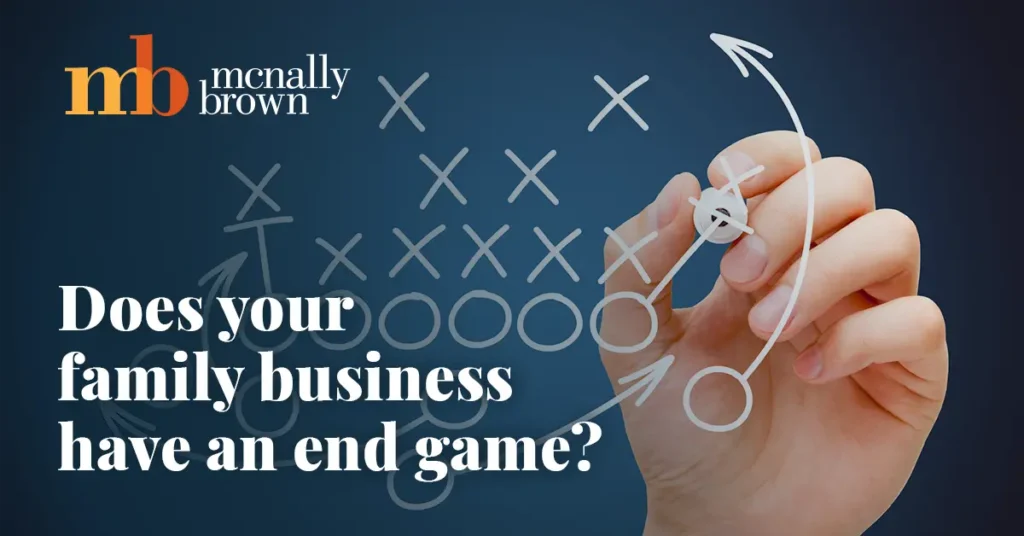Strategic Planning and Family Business
PART 2: The Risks of Misalignment
Preamble
In this second instalment* of a three part series we build on the initial premise in part one that the ‘Family’ dimension of ‘Family Business’ can be the secret weapon of business success.
But the family dimension is not without its own pitfalls; hence, the one in three odds of successfully transitioning from the first generation to the next. In this article we will discuss how aligning the family vision and objectives with the business strategy is crucial to long term success, and examine where the gaps between the two often lie.
Based on our experience in family businesses, we believe that the benefit of capturing a vision of the future within a documented strategic plan is at the core of a successful business. Such plans telegraph to management, employees and family stakeholders the essence of where and how competitive advantage will be achieved and sustained. Given that the family business typically represents the most important and valuable asset of the family, undertaking a strategic planning process will pay dividends that far outweigh the investment that such planning calls for.
Putting it on Paper
Developing a business strategy often starts with identifying the company’s mission, vision and values, which defines the long term, aspirational focus of the business. A strategic planning exercise considers the external environment of the business (competition, economic factors, and so on), and the internal capabilities of the firm and its management. Out of this, decisions are taken with respect to the market positioning i.e. where the business will compete and how it will win.
The outcome of a strategic plan typically results in a set of business goals that align with the overall vision and can be reasonably executed. Such business goals often relate to growth targets, financial performance, operational improvements, new markets, or acquisitions.
Once a strategic plan is in place, it is typically reviewed and adjusted based on changes in the environment as required. In smaller businesses, this process is often informal and may be intuitive to the founder, without formal goals or documents in place. As a business grows, complexities multiply. For a business to be sustainable beyond the founder stage a more formal approach is often needed.
For a family owned business, strategy formulation must incorporate the vision, values and objectives of the family itself. This is not to say that the family dictates to management about how and where the business competes, but rather that the family owners are aligned with the chosen strategic direction. Having a forum for the family to have healthy discussions and debate on such matters is vital.
Aligning the Family and the Business
In a first generation family business, the vision and values of the founders and the business are often deeply held by the founder, but may not be widely communicated or shared. As the business evolves and other family members rise through the ranks, the vision and values may start to shift, or may not be well understood by the next generation. Often, deliberate discussion and planning is needed to transfer the knowledge and ideas of the founding generation to the next and shape or refine them to match the new family and business reality.
If the family and business vision and values are aligned and there is support for long term aspirations of the business, the next aspect to explore is the family’s objectives and expectations with respect to risk tolerance, family cash flow needs, dividend policy, and family commitment to the business. These family objectives then need to be integrated and aligned with the business strategy and are particularly important during generational transitions. Such transitions often create additional demands for capital in the form of funds for senior generation retirement or share repurchases. These situations can significantly reduce the capital available to fund the business strategy. As such, careful planning and forecasting is required to ensure such events do not impair business operations.
The Risks of Misalignment: The Market Basket Fiasco
Every business family should have a contingency plan in the event that the family’s objectives do not align with the business’ strategic plan. Proceeding with a business strategy when there is a clear misalignment will almost inevitably have significant negative repercussions for the business and the family.
For example, consider the case of The Market Basket, a 71 store family owned grocery store chain based in the U.S. Northwest. In the summer of 2014, the Company made front page news when employees began a strike in protest of the board’s firing of the family CEO, effectively shutting the business down. The firing of the CEO was due to the fact that he had championed a strategy of maintaining company ownership of real estate in order to keep grocery prices low and remain competitive, a key success factor in their business model. Other family shareholders did not share the CEO’s philosophy on grocery pricing, but rather were seeking to transfer the real estate assets to a separate company, with a view to realizing improved returns on their investment. The standoff ended after six weeks when the former CEO struck a deal to buy out his family members and take control of the business once again.
On the one hand, the success of The Market Basket over the last 100 years demonstrates uncommon resiliency, strong values and loyalty to family leaders. On the other hand, it demonstrates that the family dimension is also a source of vulnerability where the family vision does not align with the business strategy.
Where family and business strategies are at odds there needs to be a means for open and proactive dialogue to address these differences. Structures such as Owner’s Councils and regular family meetings can be invaluable in helping head off destructive showdowns of the kind The Market Basket experienced. There is a need to take an objective look at choices they face as a business family and make difficult decisions about the family legacy and future of the business – this subject will be discussed in instalment three of this series.
Further Reading

Does your family business have an end game?
For family businesses, strategic planning really begins and ends with a single powerful question: Why are you in business? The answer to this question will affect the quality of decision making by business families.

Strategic Planning and Family Business: PART 3: Defining the End Game
In this third and final installment* we explore how family legacy decisions can affect strategy and how good planning can mitigate risk in today’s rapidly changing business environment.


